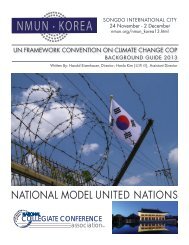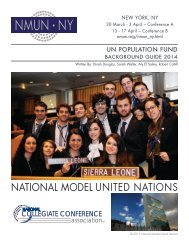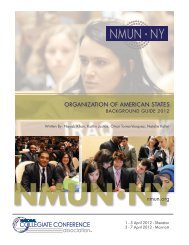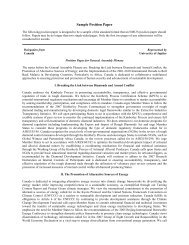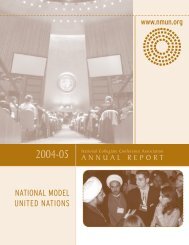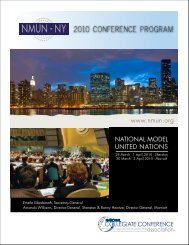UNCTAD Background Guide - National Model United Nations
UNCTAD Background Guide - National Model United Nations
UNCTAD Background Guide - National Model United Nations
Create successful ePaper yourself
Turn your PDF publications into a flip-book with our unique Google optimized e-Paper software.
to tailor to each state. 149 Investment options can broadly be divided into market stability, physical capital<br />
investment, social investment, and institutional investment. 150<br />
The first policy option is to attempt to balance the “boom and bust” cycles of commodity price volatility. These<br />
cycles are often uneven, with “boom” periods not always balancing the “bust” periods and vice versa, and lead to<br />
violent swings in capital flows and government spending. 151 Investments in stability work to balance market cycles<br />
through stabilization funds, price hedging, and the accumulation of central bank reserves. 152 To better illustrate these<br />
policies, in 2008, Mexico purchased an option to sell its 2009 oil production for $70 per barrel (at the time oil was<br />
over $100 per barrel). 153 When the price of oil collapsed to below $40 per barrel in 2009, Mexico exercised its<br />
option to sell at nearly twice the market price. 154 While not completely balancing the reduction from $100 per barrel,<br />
this action significantly reduced the volatility Mexico experienced. Similarly, Chile’s Economic and Social<br />
Stabilization Fund uses copper export revenues to balance government spending against price volatility. 155<br />
Investment in physical capital, as in the case of the <strong>United</strong> Arab Emirates mentioned above, contributes to<br />
sustainable development by creating or strengthening other sectors of the economy. These investments generally<br />
support the economy in two forms: 1) basic public infrastructure including transportation, communications, energy<br />
production, and public works (schools, hospitals, etc.), and 2) collateral infrastructure to support or create other<br />
sectors like agriculture, tourism, and other service industries. 156 Collateral infrastructure investment, whereby other<br />
sectors can use the same infrastructure built for extractive industries, not only combats the resource curse, but also<br />
counters Dutch Disease by strengthening other industries. 157 Building on recent copper price booms, Zambia is an<br />
example of a state that has sought this form of investment to diversify its economy beyond dependence on<br />
mining. 158 Zambia’s Fifth <strong>National</strong> Development Plan and Vision 2030 strongly emphasized improvements to<br />
transportation, communications, and power generation—the foremost constraints to economic growth. 159 While the<br />
commodity price crashes of 2008 and 2009 severely inhibited progress on this plan, Zambia made significant gains<br />
in the quality of its roadways, and expressed its continued resolve in the Sixth <strong>National</strong> Development Plan. 160<br />
Social investment focuses on many of the same forms of infrastructure as physical capital investment, but with the<br />
purpose of improving human capital to increase productivity. 161 Investing in education, healthcare, sanitation, and<br />
access to clean water, along with investments in transportation and power production, all work to develop a more<br />
educated, healthier, and productive workforce. 162<br />
Institutional investment in good governance, though not a concrete, financial investment, is perhaps the best method<br />
of harnessing gains from resource extraction for development. Studies using World Bank economic data and the<br />
149 <strong>United</strong> <strong>Nations</strong> Development Programme, Managing Natural Resources for Human Development in Low-Income Countries,<br />
2011, pp. 2-3.<br />
150 <strong>United</strong> <strong>Nations</strong> Development Programme, Managing Natural Resources for Human Development in Low-Income Countries,<br />
2011, pp. 3-5.<br />
151 <strong>United</strong> <strong>Nations</strong> Development Programme, Managing Natural Resources for Human Development in Low-Income Countries,<br />
2011, pp. 7-8.<br />
152 <strong>United</strong> <strong>Nations</strong> Development Programme, Managing Natural Resources for Human Development in Low-Income Countries,<br />
2011, pp. 7-8.<br />
153 <strong>United</strong> <strong>Nations</strong> Development Programme, Managing Natural Resources for Human Development in Low-Income Countries,<br />
2011, pp. 8.<br />
154 <strong>United</strong> <strong>Nations</strong> Development Programme, Managing Natural Resources for Human Development in Low-Income Countries,<br />
2011, pp. 7.<br />
155 <strong>United</strong> <strong>Nations</strong> Development Programme, Managing Natural Resources for Human Development in Low-Income Countries,<br />
2011, pp. 8.<br />
156 Jourdan, Challenges of LDC Resource-Based Development, 2009, p. 7.<br />
157 Jourdan, Challenges of LDC Resource-Based Development, 2009, p. 7.<br />
158 Adam, Harnessing Resource revenues for Prosperity in Zambia, 2009, pp. 37-38.<br />
159 Adam, Harnessing Resource revenues for Prosperity in Zambia, 2009, pp. 37-38.<br />
160 Republic of Zambia, Sixth <strong>National</strong> Development Plan 2011-2015, 2011, pp. 54-58.<br />
161 <strong>United</strong> <strong>Nations</strong> Development Programme, Managing Natural Resources for Human Development in Low-Income Countries,<br />
2011, pp. 8-9.<br />
162 <strong>United</strong> <strong>Nations</strong> Development Programme, Managing Natural Resources for Human Development in Low-Income Countries,<br />
2011, pp. 8-9.



